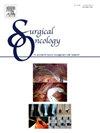Surgical outcomes of histopathological stage I pancreatic cancer with special reference to oncological differences between pStage I and ypStage I cases
IF 2.4
4区 医学
Q3 ONCOLOGY
引用次数: 0
Abstract
Objectives
Histopathological stage I pancreatic cancer (PC) consists of four entities according to the Union for International Cancer Control (UICC) 8th staging system: pStage IA (cases underwent up-front surgery, pT1 [tumor size ≤20 mm] pN0), pStage IB (cases underwent up-front surgery, pT2 [20 mm < tumor size ≤40 mm] pN0), ypStage IA and IB (i.e., underwent neoadjuvant treatment [NAT]). This study aimed to evaluate surgical outcomes in patients with histopathological stage I PC ((y)pStage I).
Methods
Patients with PC who underwent resection and were diagnosed with (y)pStage I were included in this study (n = 121). We evaluated and compared recurrence-free survival (RFS) and overall survival (OS) among these four categories: pStage I vs. ypStage I, (y)pStage IA vs. IB, ypStage IA vs. IB, and pStage IA vs. IB.
Results
There was no difference in the prognosis between pStage I and ypStage I cases, even though ypStage I included more advanced cases at NAT initiation. For pStage I (n = 25), no differences in prognosis were noted between pStage IA and IB (median RFS, 24 vs. 21 months, p = 0.871; median OS, 49.5 vs. 35.5 months, p = 0.213). However, in the ypStage I cohort (n = 96), there was significantly better RFS in ypStage IA (median RFS, 42 vs. 14 months, p = 0.0114; median OS, 52 vs. 36 months, p = 0.250).
Conclusions
Survival was comparable between pStage I and ypStage I cohorts, although the subcategories within each cohort (IA vs. IB) had different clinicopathological characteristics and outcomes.
组织病理学I期胰腺癌的手术结果,特别参考I期和I期病例的肿瘤学差异
目的:根据国际癌症控制联盟(UICC)第8期分期系统,组织病理学I期胰腺癌(PC)分为4个阶段:pia期(前期手术,pT1期[肿瘤大小≤20mm] pN0), pib期(前期手术,pT2期[20mm <];肿瘤大小≤40 mm [pN0), ypStage IA和IB(即接受新辅助治疗[NAT])。本研究旨在评估组织病理学I期PC ((y)pStage I)患者的手术结果。方法接受手术切除并诊断为(y)pStage I的PC患者纳入本研究(n = 121)。我们评估并比较了pStage I vs. ypStage I、(y)pStage IA vs. IB、ypStage IA vs. IB和pStage IA vs. IB这四种类型的无复发生存期(RFS)和总生存期(OS)。结果pStage I和ypStage I的预后没有差异,尽管ypStage I在NAT启动时包括更晚期的病例。对于pi期(n = 25), pia期和IB期预后无差异(中位RFS, 24个月vs 21个月,p = 0.871;中位OS, 49.5 vs. 35.5个月,p = 0.213)。然而,在ypi期队列(n = 96)中,ypia期患者的RFS明显更好(中位RFS, 42 vs. 14个月,p = 0.0114;中位OS, 52 vs 36个月,p = 0.250)。尽管每个队列中的亚类别(IA与IB)具有不同的临床病理特征和结果,但pStage I和ypStage I队列的生存率具有可比性。
本文章由计算机程序翻译,如有差异,请以英文原文为准。
求助全文
约1分钟内获得全文
求助全文
来源期刊

Surgical Oncology-Oxford
医学-外科
CiteScore
4.50
自引率
0.00%
发文量
169
审稿时长
38 days
期刊介绍:
Surgical Oncology is a peer reviewed journal publishing review articles that contribute to the advancement of knowledge in surgical oncology and related fields of interest. Articles represent a spectrum of current technology in oncology research as well as those concerning clinical trials, surgical technique, methods of investigation and patient evaluation. Surgical Oncology publishes comprehensive Reviews that examine individual topics in considerable detail, in addition to editorials and commentaries which focus on selected papers. The journal also publishes special issues which explore topics of interest to surgical oncologists in great detail - outlining recent advancements and providing readers with the most up to date information.
 求助内容:
求助内容: 应助结果提醒方式:
应助结果提醒方式:


